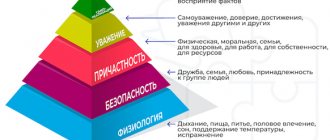According to Freud's theory, the process of personality formation begins at birth and goes through four stages. Each of these stages is associated with a specific area of the body - one or another erogenous zone (mouth, nose, ear, eye, anus, urethra, skin, navel).
On the basis of this idea, academicians V. Ganzen and V. Tolkachev developed vector psychology. This is the doctrine of eight vectors in a person’s character, called “applied system-vector psychoanalysis,” the essence of which boils down to the fact that a person cannot exist alone.
In system-vector psychology, a vector is a set of human qualities that form its system of values, morality, character, and behavioral characteristics. All vectors are innate and do not change throughout life. In this regard, each of these vectors sets a special scenario for a person’s life, and by studying them, you can understand what kind of person this person is and how to behave with him.
There are 8 vectors, that is, 8 types of human “direction”. The vector talks about what exactly a person likes, what kind of self-realization he is instinctively drawn to, what gives him pleasure. To realize his vector in society, a person plays a certain role in it. The name of the vector is identical to the human sensitive zone. So, let's begin:
Muscle vector.
General characteristics a) the color of greatest comfort is black
b) geometry of the greatest comfort - rectangle, brick;
c) place in a quartel - the inner part of the quartel SPACE, introvert - even double introvert
d) type of thinking - practical, involuntary-autistic, visual-effective.
Key task: monotonous physical work for progressive movement towards the goal. Species role: ordinary hunter or gatherer. Possible disadvantages: lack of motivation to improve work.
External signs
- Large build. “Man-mountain.”
- Stable (they say about someone like this: “Stands firmly on the ground”).
- Strong. Body with pronounced muscle relief.
- Wide, thick neck.
A person loves to work his muscles: a sport that allows you to build muscle mass; physical labor, namely carrying heavy loads, working in the field, with heavy equipment - is necessary for them. A person with a muscle vector in the absence of other vectors is a modest person with a minimum of needs and aspirations. Eating, a roof over his head, working, sleeping - the rest: science, art, entrepreneurship - are not for him. In combination with other lower vectors, it strengthens them, as if integrating into their desires and properties.
He doesn’t know how to make decisions, but he is a good performer - he is a follower. Muscular people are almost incapable of acting independently; they will do as they are told. They are unable to clearly express their own opinions; they simply follow the crowd. In their speech, instead of “I,” “we” appears. What a muscular man becomes depends on who is next to him.
Muscle plant perfectly adapts to a stable, unchanging rural landscape. Lives by the principle: as taught. This principle works in muscles in absolutely everything! Psychology of masses, crowds.
Physical labor is what it is necessary to teach a muscular child to do from an early age. He must help his parents; it is very important for him to learn to enjoy work. You need to understand that it is through muscle effort that the thinking of a muscular person is activated. He receives joy when he is engaged in physical labor, which in itself directs him in a peaceful direction. However, sports are strictly prohibited for such children, because they do not like to compete and win, they do not have such properties and data. Sport will only take them from the state of “peace” to the state of “war”.
Death is good for a muscleman; everything connected with life is suspicious for a muscleman, so a muscleman is suspicious of sex. A muscular woman creates a foundation, a foundation, giving birth to new offspring. She is the one who gives birth for real: she mowed the grass, went, gave birth under a haystack, and went on to mow. She gives birth to 10 children each so that there is a greater chance of survival. A muscular man has a contradiction - between life and death, which, however, is easily resolved through monotonous tradition and ritual: everything should be as it is with people, in a human way. When everything is not humane, then there is suspicion, because the program breaks down... not human, this is sex before marriage, sex of passion, breaking the monotony. Muscular men don’t walk around other people’s women.
An unrealized muscle vector often leads to fights and physical cruelty.
The realized muscle vector is physically strong and resilient people, manual workers, boxers, people performing monotonous physical work. Among people with a muscle vector there are often fans of sports games.
A muscular child feels very good in the womb like no other. It is connected to it through the umbilical cord as one whole - special meanings for the muscle vector. The muscular child in the womb resists birth with all its being. A newborn muscular child is fixed on the fact that everything was good in the mother’s stomach, all basic needs were satisfied on the spot and immediately, and life after birth is one suffering, since now everything must be done by yourself, on your own. These are “post-term” children, because they don't want to be born.
Muscular children are very flexible, they do not need special training. The most important thing is not to leave the muscular child hanging around and watch who he communicates with, otherwise there is a high probability that he will end up in the wrong company.
Without it, the existence of modern civilization would be impossible. One of the biggest and most important things that a person with a muscle vector does is construction.
Desired internal state: feeling like part of a mass of people.
Role in society: part of the “people”, worker, performer.
History of psychoanalysis
In 1885, Sigmung Freud went to the clinic of psychiatrist Jean Charcot to study hypnosis. There, the founder of psychoanalysis became interested in neuropathology. He observed patients with paraplegia.
In the course of his work, he was able to identify that there were differences between patients. Those who suffered from hysteria were more severely affected by paralysis than those whose illness was associated only with trauma. Additionally, the scientist was able to find out that hysteria contributes to problems in the sexual sphere.
Thoughts about the discoveries made at the Charcot clinic did not leave Freud even after the end of his internship. He turned to the works of Joseph Breuer, who developed a method of treating patients with neuroses through emotional release - catharsis.
Freud saw possible prospects in the application of this technique. Therefore, he began to combine it with hypnosis and after a year he received the first results.
But this method also lost its effectiveness over time. Freud began to realize that there were patients who did not tolerate hypnosis well or were resistant to the retrieval of painful memories.
The scientist decided that it was necessary to use all the information that the patient shared with the therapist. This information, according to Freud, interacts with each other through the structure of connections. This is how the method of free association appeared.
While working together with Joseph Breuer, Freud witnessed a new phenomenon for him. One of the patients transferred painful memories into the present and projected them onto her immediate environment. She stated that she was carrying Breuer's child. In reality, this event remained a painful memory in her memory. This became the basis for the creation of the concept of transference, the thesis of the Oedipus complex and child (infantile) sexuality.
Later, after the death of a relative, Freud used his methods to treat his own neurosis. During this period he began to study dreams. After the emerging successes, he began to use this method in further work with patients.
Based on observations and practical techniques, classical psychoanalysis emerged. Sigmund Freud presented its foundations in a number of lectures, separating them into a general cycle under the single title “Introduction to Psychoanalysis.” The book was first published in 1917.
Skin vector.
general characteristics
- the color of greatest comfort is khaki
- geometry of greatest comfort - cross
- place in the quartile – outer part of the quartile SPACE, extrovert
- type of thinking – logical, building cause-and-effect chains.
Key task: separating your space from the outside world, preserving and accumulating resources. Species role: commander of a group of hunters. In peacetime: creator and keeper of food supplies. Possible disadvantages: excessive control over the situation, stinginess.
External signs
He is not tall. Ideal, athletic body type: slim, flexible, fit. The lips of a leathernist are thin, tightly compressed - the upper lip is practically invisible.
A skinny woman is thin, lean, beautiful, swift, agile, flexible like a cat. Only a woman with skin gracefully holds space in stiletto heels - she moves beautifully and quickly in high heels. The skin gait is fast and dancing. The leather worker has an excellent sense of rhythm.
The skin person needs to think about diets less than others, but all he does is change one diet to another. Having gained a couple of extra pounds, the skinner begins to invent more and more restrictive diets for himself.
Kozhnik prefers a strict, business-like style of clothing at work and a sporty style of clothing outside of work. For men, a mandatory part of their wardrobe is a tie; a skinny woman also often uses this piece of clothing in her wardrobe. Favorite skin hairstyle: hair pulled back into a tight ponytail.
A skin gesture is an index finger that can be used to point, threaten, edify.
A leather worker's skin is delicate, sensitive, ideal, velvety. At a certain state of the vector, it is the skinners who apply tattoos to their bodies and give themselves piercings.
Kozhnik is very dexterous and flexible: he always accurately calculates his movements in space: he went around, ran around, and didn’t hit anyone.
In addition to a flexible body, a leather worker also has a flexible psyche. Its distinctive feature is the possibility of a 180-degree turn: today I will assert and prove one thing, and the next day with the same conviction - the opposite; The only question is what is more profitable for me to say at the moment. This allows them to easily and quickly adapt to any changing conditions, be it a change of job, moving to another city or even to another country. And thanks to a good analytical mind, they quickly process information. Skin type people will always be able to find their niche in a new environment. They know how to evaluate benefits, strive to increase efficiency, know how to save time and money, and get great pleasure from it. Their favorite word is “no.” However, this does not prevent them from agreeing after a while, having come up with a reasonable excuse. Skin people are mostly secretive, rarely answer questions, and do not express emotions.
An internal sense of time and space allows them to successfully do several things at once. Leather workers are focused on success, including material success. Career, wealth, social status make up the system of value guidelines of a skin person. Only he knows the ambitions and desire to be a leader, because... he loves competition. It could be sports, competition in business or love.
Logic and logical thinking are also a distinctive feature of leather workers. In their speech you can often hear the phrases: “This is not logical! Where is the logic here? It would be logical to assume”, etc.
A child with the skin vector is very active, often disobedient. Caught in some kind of prank, he will be cunning and dodge. The right approach to education will allow a leather worker to become a successful businessman or engineer in the future.
Skin children who were constantly beaten and humiliated in childhood receive psychological trauma, adapting to this pain, and the body begins to release endorphins to drown it out. Gradually, the child gets used to this kind of effect, and then becomes dependent on it, receiving specific pleasure from it. This is how masochism arises. If such a person in adulthood does not receive the usual endorphins through physical pain in sexual life, then the desire to experience pain through social frustrations and failures appears. This is how a life scenario for failure develops, a person turns into an eternal loser.
Desired internal state: a feeling of being busy, the skinner is always in motion, in development, in changes and new information.
Role in society: breadwinner, organizer, middle manager, coordinator, defender.
Stages of psychosexual development
Freud argued that the id, ego, and superego are formed through several stages of psychosexual development. At each stage, sensual (and not necessarily exclusively sexual) satisfaction is associated with a specific part of the body or erogenous zone. During the oral stage (from birth to 1 year), the infant receives sensory satisfaction mainly through the oral region. This stage is followed by the anal stage (1 to 3 years), in which satisfaction is achieved primarily through the retention and expulsion of feces. At the phallic stage (from 3 to 5 years), according to Freud, the boy realizes that he has a penis and experiences physical attraction to his mother (Oedipus complex). However, he is afraid that his father will punish him for this desire by taking away his penis. Therefore, the attraction to the mother is suppressed, and the boy begins to become attached to his father. At this stage, the girl finds out that she does not have a penis, but she wants one (the envy of penis owners). She feels that she once had such an opportunity, but was deprived of it as punishment. She believes that everything is her mother's fault, so her identification with her mother weakens, and her attachment to her father intensifies. These eventful stages are followed by a latent period (from 5 years to adolescence), when energy is directed towards the development of intellectual and social skills not related to the sexual sphere. During the genital phase (beginning in adolescence), a person strives for “mature” sexual satisfaction with a regular partner of the opposite sex.
In the case of “incorrect” development at the stages preceding the development of the genital organs, deviations in the sexual behavior of an adult may occur. For example, if the Oedipus complex was not resolved in childhood, a man may experience sexual attraction to partners who are similar to his mother. “Abnormal” development affects not only the choice of a partner. For example, if an infant bites its mother's breast during the oral stage, it may subsequently develop a "bitter" and sarcastic sense of humor. Likewise, an infant who liked to hold bowel movements rather than expel them during the anal stage may subsequently develop an anal-retentive personality characterized by stinginess and excessive attention to detail.
Olfactory vector.
general characteristics
- the color of greatest comfort is purple
- geometry of greatest comfort - zigzag
- place in the quartel – inner part of the ENERGY quartile, introvert
- type of thinking – intuitive; strategic
- people with the olfactory vector are less than 1%.
Key challenge: identifying potential hazards before they become real. Survive at all costs. Species role: shaman, sorcerer , adviser to the leader, strategic intelligence officer, eminence gray. Possible disadvantages: excessive suspicion, distrust of others.
Modern psychoanalysis
The basis of psychoanalysis remains the teachings of Sigmund Freud. His ideas about the unconscious give science a large area to study.
In the 21st century, psychoanalysis is developing in three directions:
- A psychoanalytic concept on the basis of which a direction changes its boundaries and is filled with new ideas.
- Applied psychoanalysis, which studies the manifestations of society: culture, values and social needs.
- Clinical psychoanalysis. This is a whole therapeutic method for working with clients. In therapy, the client is placed lying down on a couch and the therapist sits at the head of the bed. At the same time, the client does not see the therapist. This helps his thoughts flow freely. He gets the impression that he is having a dialogue with himself. This atmosphere allows the client to relax.
The creation of psychoanalysis as a branch of science was an important milestone in the development of psychology. Within the framework of this teaching, features of the psyche were touched upon, which help to understand the source and mechanism of a person’s internal problems
With the development of psychoanalysis, it became possible to work not only with the information that the client gives, but also to reach the depth of his unconscious thoughts.
On the verge of internal explosion
Freud emphasized that there is an unstable balance between the three personality structures, since not only their content, but also the directions of their development are opposite to each other. The instincts contained in “It” strive for their own satisfaction, dictating to a person such desires that are practically impossible to fulfill in any society. The “super-ego,” which includes a person’s conscience, self-observation and ideals, warns him about the impossibility of realizing these desires and stands guard over compliance with the norms accepted in a given society. Thus, the “I” becomes, as it were, an arena for the struggle of contradictory tendencies that are dictated by the “It” and the “Super-Ego”. This state of internal conflict in which a person constantly finds himself makes him a potential neurotic. Therefore, Freud constantly emphasized that there is no clear line between normality and pathology, and the constant tension people experience makes them potential neurotics. The ability to maintain one’s mental health depends on psychological defense mechanisms that help a person, if not prevent (since this is actually impossible), then at least mitigate the conflict between the “It” and the “Super-Ego”.
Personality structure according to Perls
The Gestalt approach - the personality structure according to Perls - is three parts of the I-awareness of reality - external reality, internal reality and abstract reality.
External awareness of reality is what you can see, hear, feel physically, smell and taste in real time... not only you, but also those around you...
Inner awareness of reality is something that only you can feel and perceive with your senses, i.e. it's what's inside your body.
Abstract awareness of reality is knowledge, reflections, fantasies, dreams, illusions, memories of the past and planning for the future... - all this constitutes the human essence.
But for a person to be happy, all three parts of Self-awareness, the entire personality structure, must work evenly...
In many psychoanalytic and psychotherapeutic schools of our time, as well as the authorities of psychoanalysis and psychotherapy listed above, the structure of a person’s personality (psyche) is used, and as a rule these are three parts of the Self - “Stereotypical Self”, “Rational Self” and “Emotional Self”.
The stereotypical self is similar to Freud's Super-Ego, Berne's Parent-Ego, and Perls' Abstract Self.
The rational self is similar to Freud's Ego, Eric Berne's Adult Self, and Fritz Perls' External Self.
The emotional self is reminiscent of Sigmund Freud's ID, Bern's Child Self, Frederic Perls's Inner Self.
SIGN UP FOR PSYCHOANALYSIS ONLINE AND GET RID OF “STRUCTURAL PERSONALITY PATHOLOGY” (make your “I”s one)
Take free tests - find out more about the depths of the psyche and the structure of your personality...
- Personality Structure Test
Personality diagnostics according to Cattell
Personality factors
Factor theory of personality
Personality Test
Personality disorder test
Read a psychoanalyst's magazine - psychological articles for self-help
- Make a personality portrait
Psychotypes of personality
Human authenticity
Personal abilities
Anxious personality disorder
- Next publication What is happiness?
- Previous publication Reich’s body-oriented psychotherapy - exercises, training
Free help from a psychologist to subscribers on Social Networks
MAIN SECTIONS: Psychological magazine Psychologist services Psychology of relationships Sexual psychology Psychoanalysis of dreams Frequently asked questions for a psychologist Psychotherapy of fears: VSD, PA Psychology of education Trainings and exercises Self-help, Self-analysis, Self-therapy
PSYCHODYAGNOSTICS: ALL TESTS WORK TESTS Personality tests Family tests Tests and articles for women Girls' tests Tests about love and relationships Tests for teenagers Tests and articles for men Social testing











